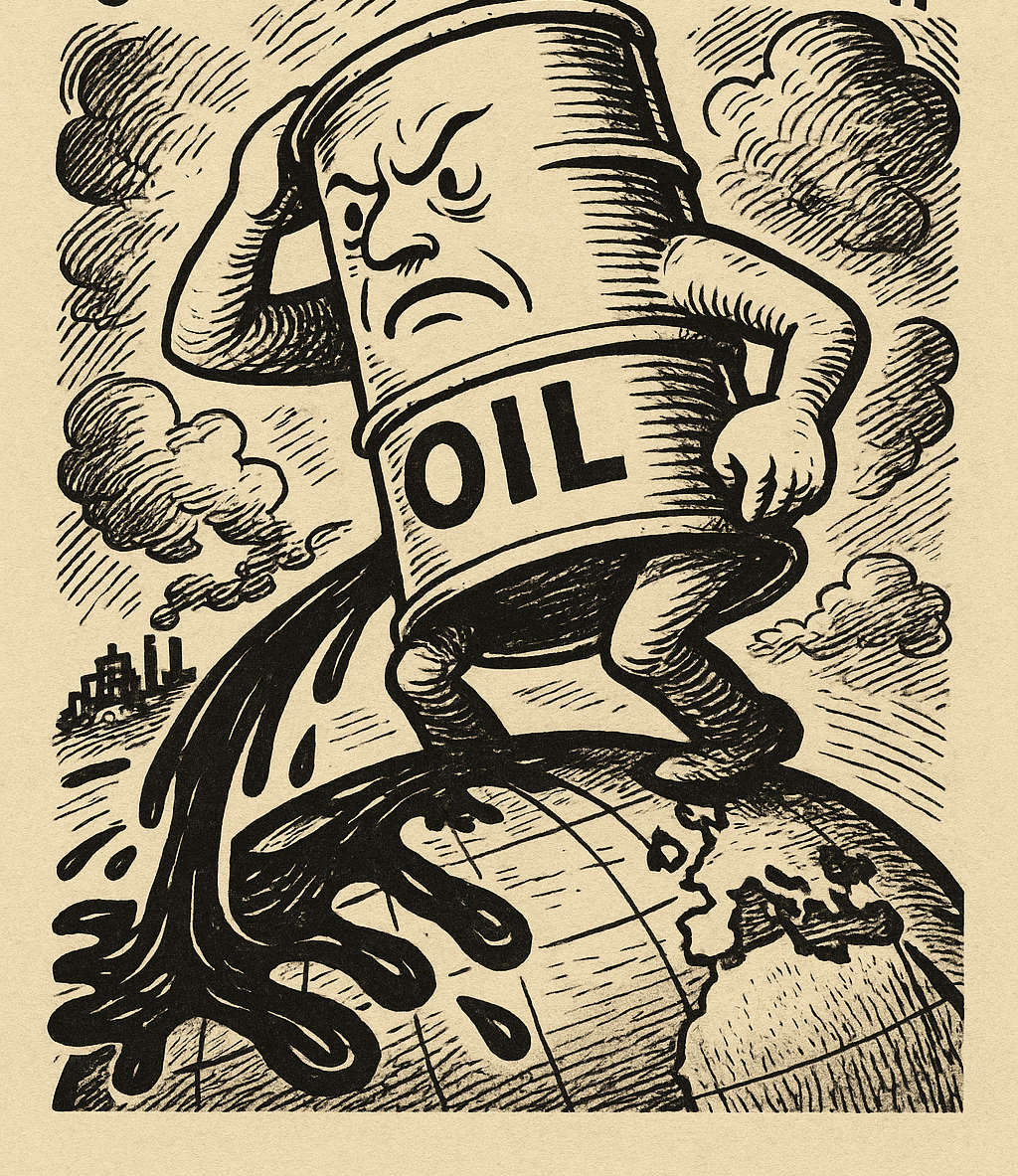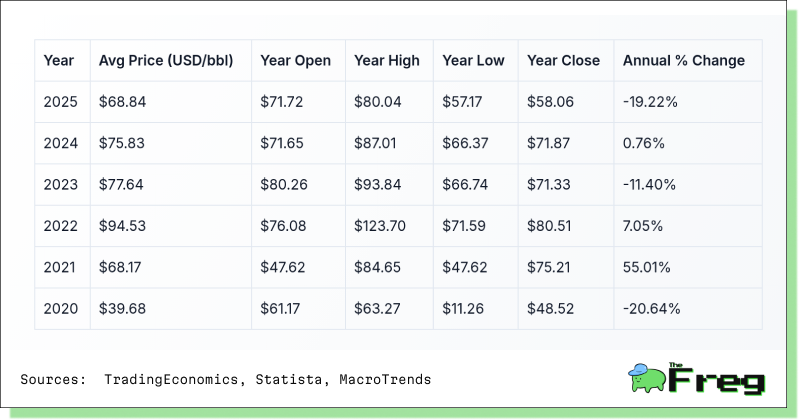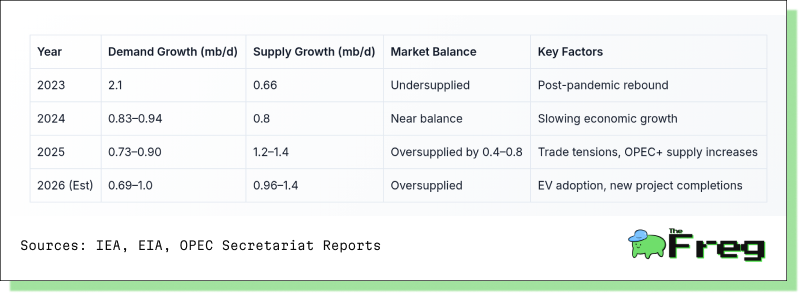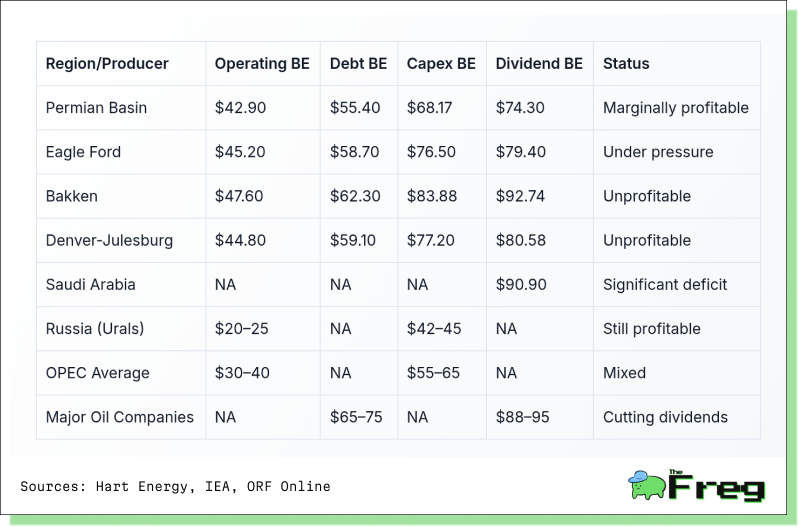Crude Reckoning: The Global Fallout of Oil's Four-Year Crash
China's energy pivot and tariff crossfire are throttling demand, leaving oil markets in a volatile freefall.

Oil prices have plunged to their lowest levels since 2021, driven by a combustible mix of surging supply, geopolitical chess, and weakening global demand. West Texas Intermediate (WTI) now hovers around $58 a barrel, down nearly
20% year-to-date—a stark reversal for a commodity that once symbolized geopolitical power and economic leverage.
The OPEC+ Shock: Production Gambit or Power Play?
In a dramatic pivot, OPEC+ has ramped up production for a second consecutive month, boosting output by 411,000 barrels per day (bpd) for June 2025. This follows similar hikes in April and May, amounting to a 44% reversal of the cartel's 2.2 million bpd cut from December 2024.
Saudi Arabia, the group's de facto leader, appears to be executing a high-stakes strategy: enforce discipline among wayward members like Iraq and Kazakhstan, regain lost market share from U.S. shale and non-OPEC competitors, and appease geopolitical pressure from Washington. President Donald Trump has vocally pushed for increased oil flows ahead of his May state visit to Riyadh.
Yet this aggressive stance comes at a steep cost. With its fiscal breakeven price hovering around $90 per barrel, Saudi Arabia risks ballooning its budget deficit from $35 billion to $75 billion.
WTI Crude Oil Price Trends (2020–2025)

A Tariff Trap: Trade Wars Undercut Demand
Trade tensions between the U.S. and China have sharply curtailed global oil demand growth. After Washington imposed tariffs of up to 145% on Chinese goods, Beijing retaliated with 84% duties on American exports—including crude oil. China's response has been swift and strategic: U.S. oil now comprises just 1% of its imports, down from over 10% two years ago.
The International Energy Agency (IEA) has slashed its 2025 demand growth projection by 300,000 bpd to just 730,000 bpd—the lowest in five years. U.S. producers, cut off from a key market, are feeling the pinch. Rig counts are falling, and WTI is slipping below key support levels as fears of a global slowdown mount.
Structural Shifts: China’s Energy Evolution
China's pivot from manufacturing to services, combined with its aggressive decarbonization goals, is reshaping energy markets. Electric vehicles now account for over half of new car sales, and an expanding high-speed rail network is displacing oil use. Globally, this has eliminated nearly 1.8 million barrels of daily demand, with China responsible for more than half of that.
Meanwhile, non-OPEC producers—led by the U.S., Brazil, and Canada—are adding over 1.1 million bpd in 2025 alone. The result: a projected surplus of 950,000 to 1.4 million barrels daily.
Global Oil Market Balance (2023–2026)

Winners and Losers: Industry and Economy
Airlines and transportation firms are among the few winners in this price plunge, enjoying dramatically lower fuel costs. However, gains are lopsided: legacy carriers like Delta and United benefit more than budget airlines grappling with depressed travel demand.
Oil-dependent economies are absorbing the heaviest blows. Venezuela and Nigeria, already financially fragile, face economic collapse as oil revenues plummet. In the U.S., shale producers—especially in high-cost regions like Bakken and Denver-Julesburg—are rapidly approaching unprofitability.
Breakeven Oil Prices by Region (May 2025)

Currency & Inflation Dynamics: A New Oil-Price Feedback Loop?
The collapse in oil prices is reverberating through currency markets. Petrodollar economies like Nigeria, Colombia, and Mexico have seen sharp depreciations in their local currencies, pushing up import costs and stoking inflation. Conversely, oil-importing countries such as India and Japan are benefiting from improved trade balances and moderated inflation pressures.
The collapse in oil prices is reverberating through currency markets. Petrodollar economies like Nigeria, Colombia, and Mexico have seen sharp depreciations in their local currencies, pushing up import costs and stoking inflation. Conversely, oil-importing countries such as India and Japan are benefiting from improved trade balances and moderated inflation pressures.
Central banks are reacting in kind. While the Federal Reserve signals potential rate cuts amid deflationary forces, several emerging market central banks are being forced into rate hikes to stabilize currencies. This policy divergence could exacerbate capital flow volatility and complicate recovery prospects in fragile economies.
Forecast: More Pain Ahead?
The consensus among analysts is grim. Goldman Sachs now sees Brent crude averaging $60 for the remainder of 2025 and $56 in 2026. The IEA projects supply will continue to outpace demand through at least 2026, putting further downward pressure on prices.
However, a few wildcards remain:
- Middle East tensions: Any disruption—particularly involving Iran—could spike prices
- U.S. interest rate cuts: A weaker dollar would make oil cheaper for global buyers
- Hurricane season: Gulf Coast supply interruptions could temporarily rebalance the market
- OPEC+ flexibility: The group may reverse course if the pain proves too great
The Consumer Dividend—and Climate Cost
For now, consumers are reaping the rewards. U.S. gasoline prices average $3.12 per gallon, with sub-$3 fuel a realistic possibility during the summer driving peak. This de facto tax cut is boosting disposable income and economic activity.
Yet there's a catch: lower oil prices reduce the incentive to transition to renewables. While solar and wind are increasingly cost-competitive, fossil fuels remain dominant. The volatility also clouds energy investment decisions, as companies defer new projects and governments recalibrate climate policies.
As the saying goes, "The cure for low prices is low prices." If this spiral continues, unprofitable wells will shut down, and equilibrium may eventually return. Until then, oil markets are caught in a vortex of supply excess, geopolitical maneuvering, and demand uncertainty—a crude reckoning with global consequences.






